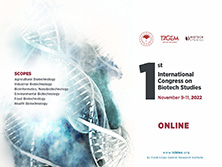EVALUATION AND SELECTION FOR WINTER HARDINESS IN 10 LENTIL RECOMBINANT INBRED LINE POPULATIONS FOR ADAPTATION TO HIGH ELEVATION REGIONS OF TURKEY
2 Harran Üniversitesi Ziraat Fakültesi Tarla Bitkileri Bölümü, Şanlıurfa
3 U.S. Department of Agriculture, Agricultural Research Service, and the Department of Crop and Soil Sciences , 303W Johnson Hall, Washington State University, Pullman, Washington 99164-6434 USA
4 International Center for Agricultural Research in the Dry Areas (ICARDA), P.O.Box 5466, Aleppo, Syria - Low winter temperature is a major limiting factor for productivity of lentil (Lens culinaris Medik.) as a winter crop in high elevation regions of Turkey. Due to insufficient winter hardiness, farmers plant lentil in spring. The goal of this study was to evaluate and select winter hardy lentil germplasm that was well adapted to high elevation regions. For the study, we used 10 lentil recombinant inbred line populations (RIL) developed from crosses of winter-hardy and winter susceptible parents. The ten F6 derived RIL populations (with over 100 RILs per population) were planted in the fall in a randomized complete block design with three replications. The experiments were established at Haymana, Turkey and Pullman, WA, USA in the winters of 1997/98 and 1998/99. All RIL populations were evaluated for winter survival and days to first flower.
From that initial evaluation 200 RILs from the 10 RIL populations were advanced to Regional Yield Trials and evaluated during 1999-2004 in Turkey. Survival at both locations was the lowest for the non-winter hardy x winter hardy populations, while mean survival was highest for the hardy x intermediate hardy crosses at Haymana and the hardy x hardy crosses at Pullman. Days to first flower average was the latest for the hardy x hardy crosses and earliest for the winter susceptible x intermediate hardy crosses at Haymana. In general, the hardy parents had the latest flowering dates. The highest yields were obtained from the intermediate hardy x intermediate hardy crosses. In conclusion, one can say that higher yields could be obtained not only from winter hardy lines but also lines with acceptable developmental adaptive traits such as an early first flowering date, in high elevation winter growing zones.
Keywords : Lentil, Recombinant Inbred Line, Population, Survival, First Flowering Date, High Elevation Regions, First Flowering Date, Selection















